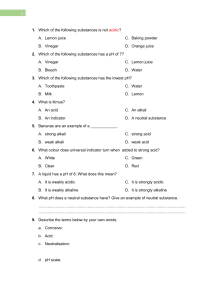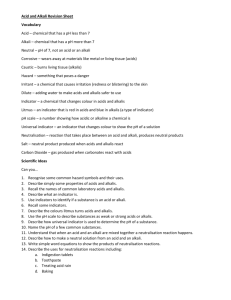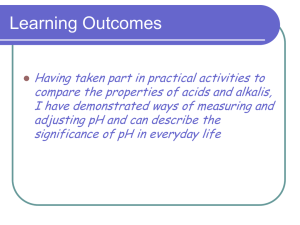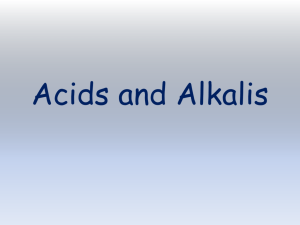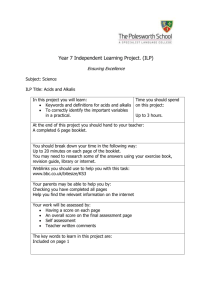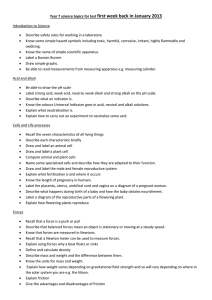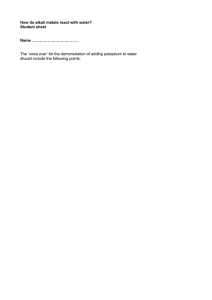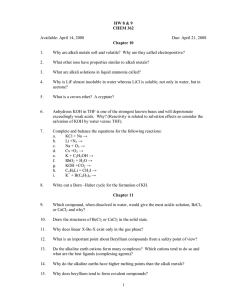Acids and Alkalis - No Brain Too Small
advertisement
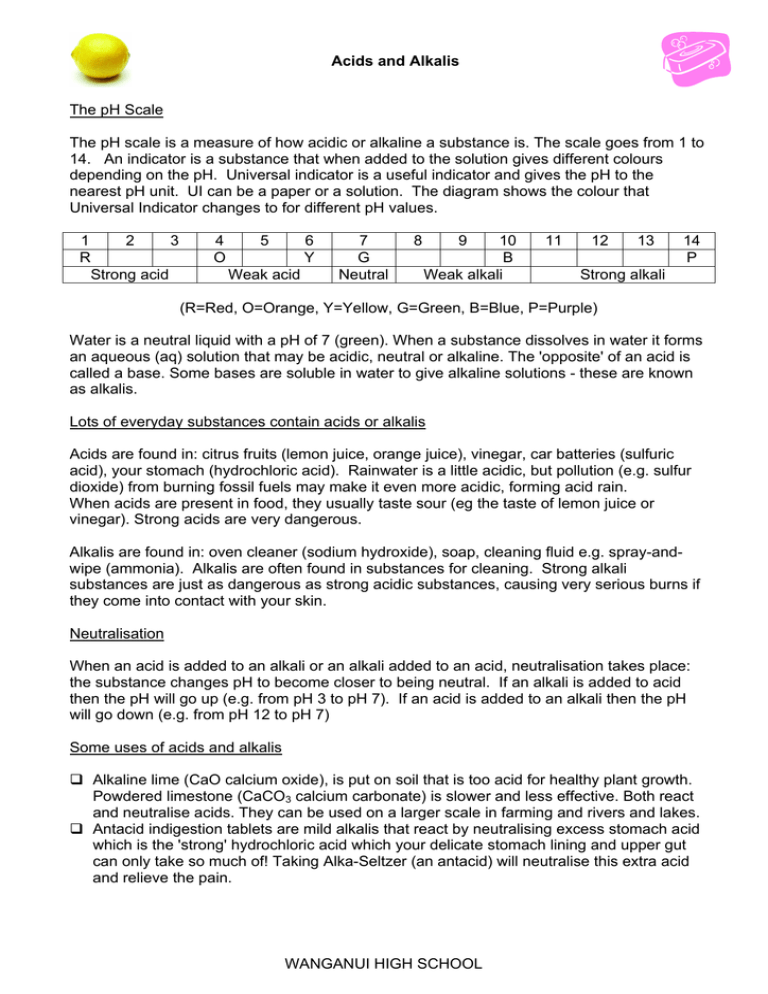
Acids and Alkalis
The pH Scale
The pH scale is a measure of how acidic or alkaline a substance is. The scale goes from 1 to
14. An indicator is a substance that when added to the solution gives different colours
depending on the pH. Universal indicator is a useful indicator and gives the pH to the
nearest pH unit. UI can be a paper or a solution. The diagram shows the colour that
Universal Indicator changes to for different pH values.
1
2
3
R
Strong acid
4
O
5
6
Y
Weak acid
7
G
Neutral
8
9
10
B
Weak alkali
11
12
13
14
P
Strong alkali
(R=Red, O=Orange, Y=Yellow, G=Green, B=Blue, P=Purple)
Water is a neutral liquid with a pH of 7 (green). When a substance dissolves in water it forms
an aqueous (aq) solution that may be acidic, neutral or alkaline. The 'opposite' of an acid is
called a base. Some bases are soluble in water to give alkaline solutions - these are known
as alkalis.
Lots of everyday substances contain acids or alkalis
Acids are found in: citrus fruits (lemon juice, orange juice), vinegar, car batteries (sulfuric
acid), your stomach (hydrochloric acid). Rainwater is a little acidic, but pollution (e.g. sulfur
dioxide) from burning fossil fuels may make it even more acidic, forming acid rain.
When acids are present in food, they usually taste sour (eg the taste of lemon juice or
vinegar). Strong acids are very dangerous.
Alkalis are found in: oven cleaner (sodium hydroxide), soap, cleaning fluid e.g. spray-andwipe (ammonia). Alkalis are often found in substances for cleaning. Strong alkali
substances are just as dangerous as strong acidic substances, causing very serious burns if
they come into contact with your skin.
Neutralisation
When an acid is added to an alkali or an alkali added to an acid, neutralisation takes place:
the substance changes pH to become closer to being neutral. If an alkali is added to acid
then the pH will go up (e.g. from pH 3 to pH 7). If an acid is added to an alkali then the pH
will go down (e.g. from pH 12 to pH 7)
Some uses of acids and alkalis
Alkaline lime (CaO calcium oxide), is put on soil that is too acid for healthy plant growth.
Powdered limestone (CaCO3 calcium carbonate) is slower and less effective. Both react
and neutralise acids. They can be used on a larger scale in farming and rivers and lakes.
Antacid indigestion tablets are mild alkalis that react by neutralising excess stomach acid
which is the 'strong' hydrochloric acid which your delicate stomach lining and upper gut
can only take so much of! Taking Alka-Seltzer (an antacid) will neutralise this extra acid
and relieve the pain.
WANGANUI HIGH SCHOOL
Bicarbonate or powder or baking powder can be used with sour milk (acidic) for raising
action in baking. The acidic milk reacts with the sodium hydrogen carbonate (NaHCO3) to
form carbon dioxide gas to give the rising action.
Acidic bee stings can be soothed, i.e. neutralised by calamine lotion, which is a mild alkali
and you can also use baking soda ('bicarb of soda' = sodium hydrogen carbonate).
Alkaline wasp stings can be neutralised with vinegar which is a weak acid.
Acid Rain
Acid rain increases the rate of corrosion of stonework (particularly limestone) and metal
structures. Acid rain makes water too acid for some aquatic organisms to live and this in turn
affects food chains e.g. salmon do not like water with a pH below 4.5!
Some general reactions of acids
1. Acid + Base → Salt + Water
2. Acid + Carbonate → Salt + Water + Carbon Dioxide
3. Acid + Metal → Salt + Hydrogen
N.B. Unreactive metals (copper, silver, gold) will not react with acids.
Reactions involving hydrochloric acid produce chlorides.
Reactions involving sulfuric acid produce sulfates.
Reactions involving nitric acid produce nitrates.
SOME KEY WORDS
acid - A chemical that has a pH of less than 7
acidic - Description used for a chemical that is an acid
alkali - A chemical that has a pH of more than 7
alkaline - Description used for a chemical that is an alkali
antacid - An alkaline chemical that treats indigestion
corrosive - Can chemically attack another substance
hazard - Another word for danger
hydrochloric acid - An acid with the formula HCl
indicator - A chemical that shows how acidic a substance is
Indigestion - Caused by too much acid in the stomach
irritant - A type of chemical that irritates the skin
litmus - An indicator that is red in acid and blue in alkali
neutral - Having a pH of 7
neutralising - Making something neutral
pH number - A number showing how acidic a chemical is
sodium hydroxide - An alkali with the formula NaOH
solution - A liquid with a solid dissolved in it
stomach – Part of the body that contains hydrochloric acid
sulfuric acid - An acid with the formula H2SO4
universal indicator - An indicator that shows the pH of a solution
WANGANUI HIGH SCHOOL

